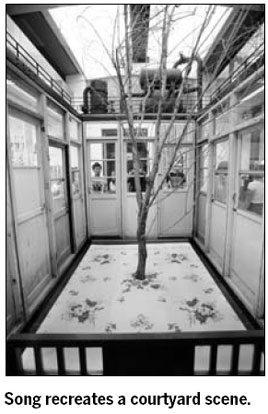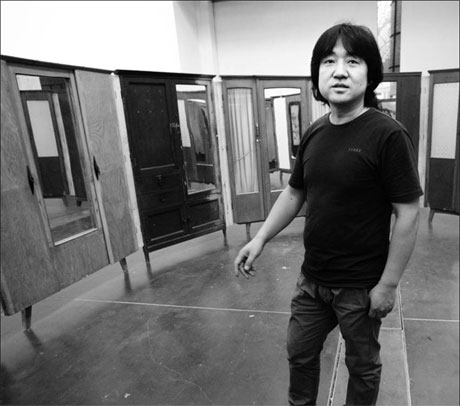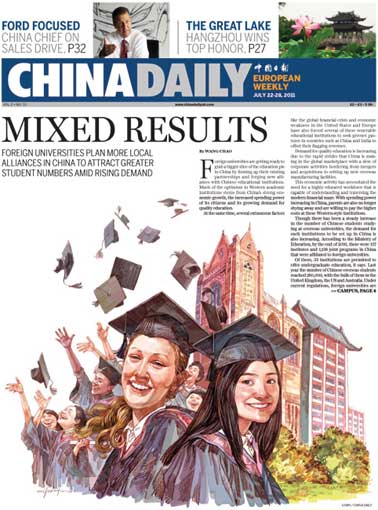Art
New may be silver, but old is gold
Updated: 2011-07-22 08:02
By Chen Nan (China Daily)
|
Song Dong's latest exhibition reflects the aesthetics of low-income people living in courtyard homes. Photos by Du Lianyi / China Daily |
A Beijing hutong resident converts items of everyday use into a stunning piece of installation art that, he says, distills the wisdom of the poor. Chen Nan reports.
The 8,000 square meters of exhibition space at the Ullens Center for Contemporary Art (UCCA) is known for displaying the latest in the art world.
But for an ongoing exhibition, the corridors are packed with mundane objects of everyday usage.
The man behind the show is Song Dong. The 45-year-old artist was born and raised in Beijing and lives in the city with his parents in a tiny house crammed with wardrobes, roof tiles, bicycles and plank beds.
The used items, mostly recycled, titled The Wisdom of the Poor, are tied to Song's deepest memories and emotions.
"For me the hoarding represents an artwork," he says. "Life is art. Art is life."

It took Song six years to put together the display of items used by low-income families living in Beijing's dazayuan, where several families share one courtyard house.
Growing up in Beijing's hutong, or traditional alleyways, Song has an insight into the dynamics of dazayuan and how the residents learn to accommodate one another to live comfortably.
From a pigeon coop sitting atop the roof of a house to a double bed built around a tree, the artist fills the exhibition halls with installations that reveal how poor people economize to transform their homes, streets, communities and lives.
Their wisdom is reflected in the way they balance public and private space, personal and group rights.
"The dazayuan I've been living in has 18 families. The residents there are poor but they have a unique sense of aesthetics and know how to make their lives easier," he says.
The Wisdom of the Poor is part of a series that includes Para-Pavilion - a rebuilding of his 100-year-old parental home and community at the Venice Art Biennale 2011, and another display at his home, located in a narrow hutong in the west of the capital.
"I cannot live without hutong and dazayuan. Although my studio is big and I have enough money to buy an apartment, I prefer living in my old house. I still live the way my parents did, storing cabbages in winter and burning honeycomb briquettes to warm the house in winter," he says.
His obsession with hutong bric-a-brac comes from his mother, Zhao Xiangyuan, who died when she was 71.
Song remembers how his mother never threw away anything, no matter how insignificant it seemed. The house Song was born in was 5.8 sq m and the first bed he had was a suitcase, he recalls.
"My mother often said: 'We are poor people. No matter how wealthy we become, poverty will always run in our veins'," he says.
"My childhood memories are all about tidying up, organizing and finding places to store our things."
In 2002, after his father's sudden death from a heart attack, Song began helping his mother clear up things that she was reluctant to throw away.
He was shocked to discover the number of things his mother had stocked up. They took up every corner of their house and even spilled out into the courtyard and hutong.
It was this haul that inspired the widely acclaimed exhibition, Wu Jin Qi Yong, or Waste Not, which was displayed at Museum of Modern Art, New York, in 2009. It put on display more than 10,000 items collected by Song's mother, including toothpaste tubes, water pots and burnt-out light bulbs.
It was a record of 60 years of a Chinese woman's life - showcasing her attachments and way of life.
"I felt warm and powerful when I saw those items," Song says.

"When I was a child, I took it for granted, but as I grew up, I became interested in how the poor manage to create space and cozy living conditions."
Waste Not led to more research and interviews. Over the past six years, he has scoured second-hand markets to collect items that are disappearing in everyday life, such as benches and iron pans.
"The exhibition is a series. I will keep on adding items that show the wisdom of the poor. I value their philosophy of life, putting together the exhibition comes naturally to me as that is my life," he says.
One of the most original figures in contemporary Chinese art, Song started painting early and prolifically.
He studied oil painting at Beijing's Capital Normal University and tends to favor familiar, inexpensive and everyday materials.
He finds meaning in what most people would call junk.
Nothing should be discarded, he says, insisting that everything can be recycled.
"Now, most of my works are for my 3-year-old daughter. I hope one day she will enjoy the art of life because everything in life matters."
(China Daily 07/22/2011 page20)
E-paper

Ringing success
Domestic firms make hay as shopping spree by middle class consumers keeps cash registers ringing in Nanjing
Mixed Results
Crowning achievement
Living happily ever after
Specials

Ciao, Yao
Yao Ming announced his retirement from basketball, staging an emotional end to a glorious career.

Going the distance
British fitness coach comes to terms with tragedy through life changes

Turning up the heat
Traditional Chinese medicine using moxa, or mugwort herb, is once again becoming fashionable

